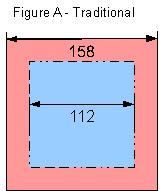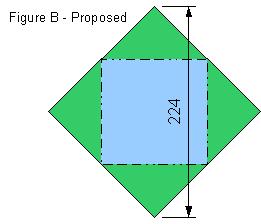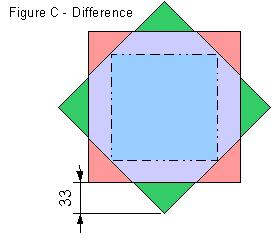Pyramid Prospect Proposal
This is a study and proposal to use a Diamond patten rather than the traditional Square patten for prospecting limestone blocks for our larger pyramids.
The traditional method.
The proposed method.
The difference.
An analysis
Okay, that seems to make sense, but just how much of a difference is this going to make ?We are currently working on a 1240 block pyramid in CotS that I'm using to do a rough estimate as to the savings of following the diamond method. We have tapped about 9,000 rods, and have about 450 blocks located. So that gives us one block every 20 rods.
So to crack 1/2 of the blocks (620) we need an area of 12,400 coordinates square (about 112x112) - the blue area in the figures above. For all blocks, we need an area of 24,800 coordinates square (about 158x158 square - the red area, or a diamond with a height/width of 224 - the green area).
The areas of difference (the red/green triangles in Fig C) cover a combined area of 4,356 coordinates, and should count for about 218 blocks.
The worst case in the red areas would be at a corner, and that block would need to be pushed 158 coordinates. In the green area, the worst case is 112 coords, a difference of 46 coords. Blocks at the points where the green and red areas meet would have to be pushed the same distance. So let's assume the average distance saved is 46 / 2, or 23 coordinates.
Update : I calculated the average coords to move all possible blocks in a Red and Green triangle. The actual average saving was 26 coords, better than the above guess. That woulds out to an average saving of 4.5 coords for all blocks. I verified this by calculating the average coords to move every possible block in the Traditional and Diamond pattens, and again came up with a difference of 4.5 -- Siara
Multiplying that by the 218 blocks in these areas give us a total savings of 26*218 = 5,668 coordinates that we don't have to push.
If we average that over all of the blocks in the site, 5,668 / 1,240 = 4.5 coords.
Conclusion
By following this new patten, we effectively have a savings equivalent of moving every block in the site 4.5 coordinates closer to the build site - which I feel is a very significant difference.Expressed as time saved : 26*218=5,668 coords - 8 pushes to a coord 8*5,668 = 45,344 pushes - if we can push once per second = 12 person hours of pushing eliminated. That's about a 5.7% savings over all.
Search process
In order to make our search site fit the diamond patten, we would search in the usual square method until we have cracked 1/2 of the total blocks (the blue square). Then, when setting new rows of rods, simply skip the first coordinate in the rows at both ends. If that does not give us the total blocks needed, the diamond can be extended anywhere, as any point on it's edge is the same distance to the center.
Savings for each Pyramid type
| Teirs | Blocks | Area | Square Length | Ave Coord | Diamond Width | Ave Coord | Ave. Save. | Total Save. | Time (Days) H:M |
|
| People | 3 | 14 | 280 | 17 | 8.5 | 24 | 8.0 | 0.5 | 6.8 | 00:00 |
| Fertile Land | 5 | 55 | 1100 | 34 | 17.0 | 48 | 16.0 | 1.0 | 53.5 | 00:07 |
| Deep Ocean | 7 | 140 | 2800 | 53 | 26.5 | 75 | 25.0 | 1.5 | 212.2 | 00:28 |
| Renewal | 11 | 506 | 10120 | 101 | 50.5 | 143 | 47.6 | 2.9 | 1461.4 | 03:14 |
| Distant Plains | 15 | 1240 | 24800 | 158 | 79.0 | 223 | 74.5 | 4.5 | 5602.4 | 12:26 |
| Many Wonders | 19 | 2470 | 49400 | 223 | 111.5 | 315 | 105.1 | 6.4 | 15750.7 | 1 11:00 |
| <Unknown> | 25 | 5525 | 110500 | 333 | 166.5 | 471 | 157.0 | 9.5 | 52610.7 | 4 20:54 |
This presumes there is one block per 20 coords, and Time presumes we get one push per second, and there are 8 pushed to move one coord.


